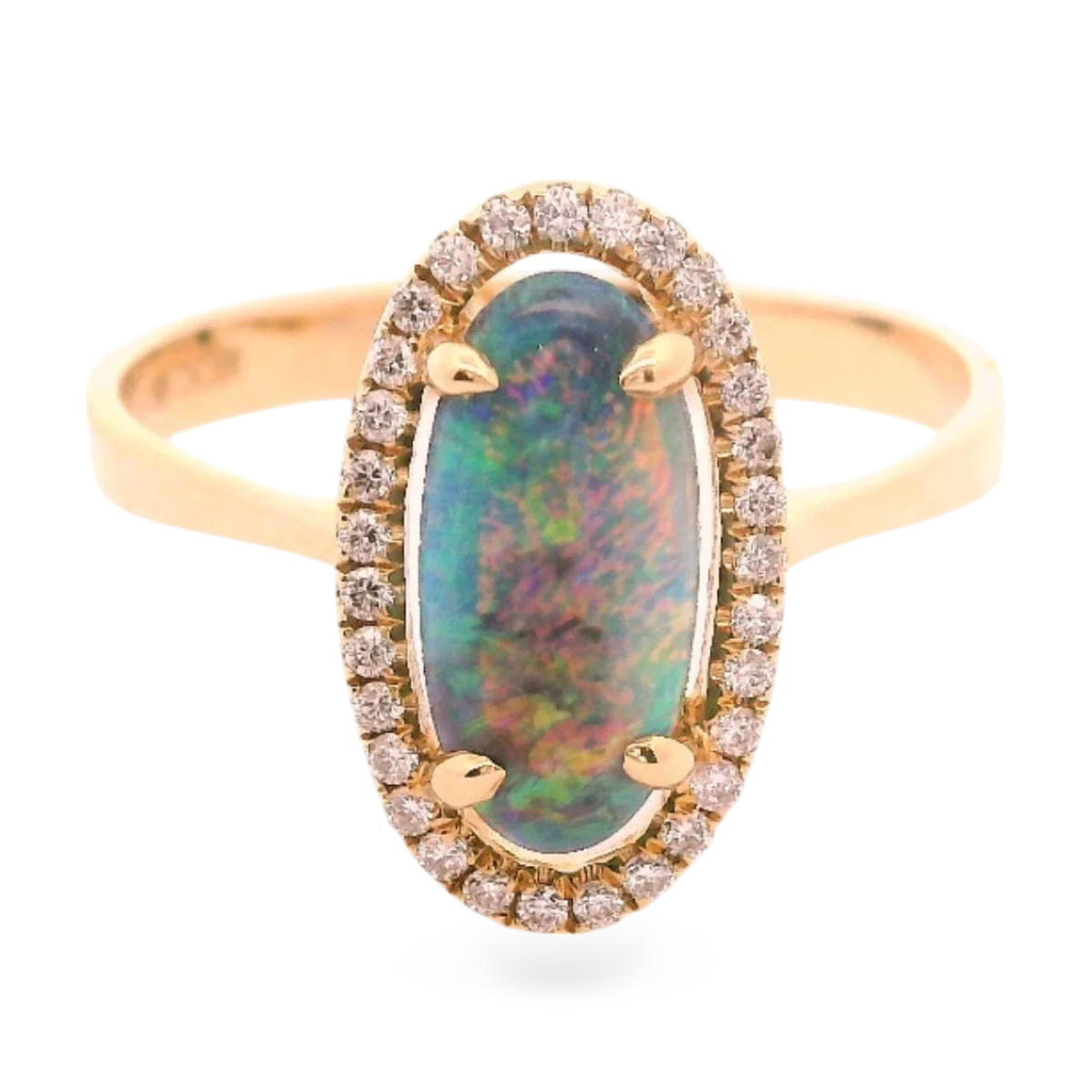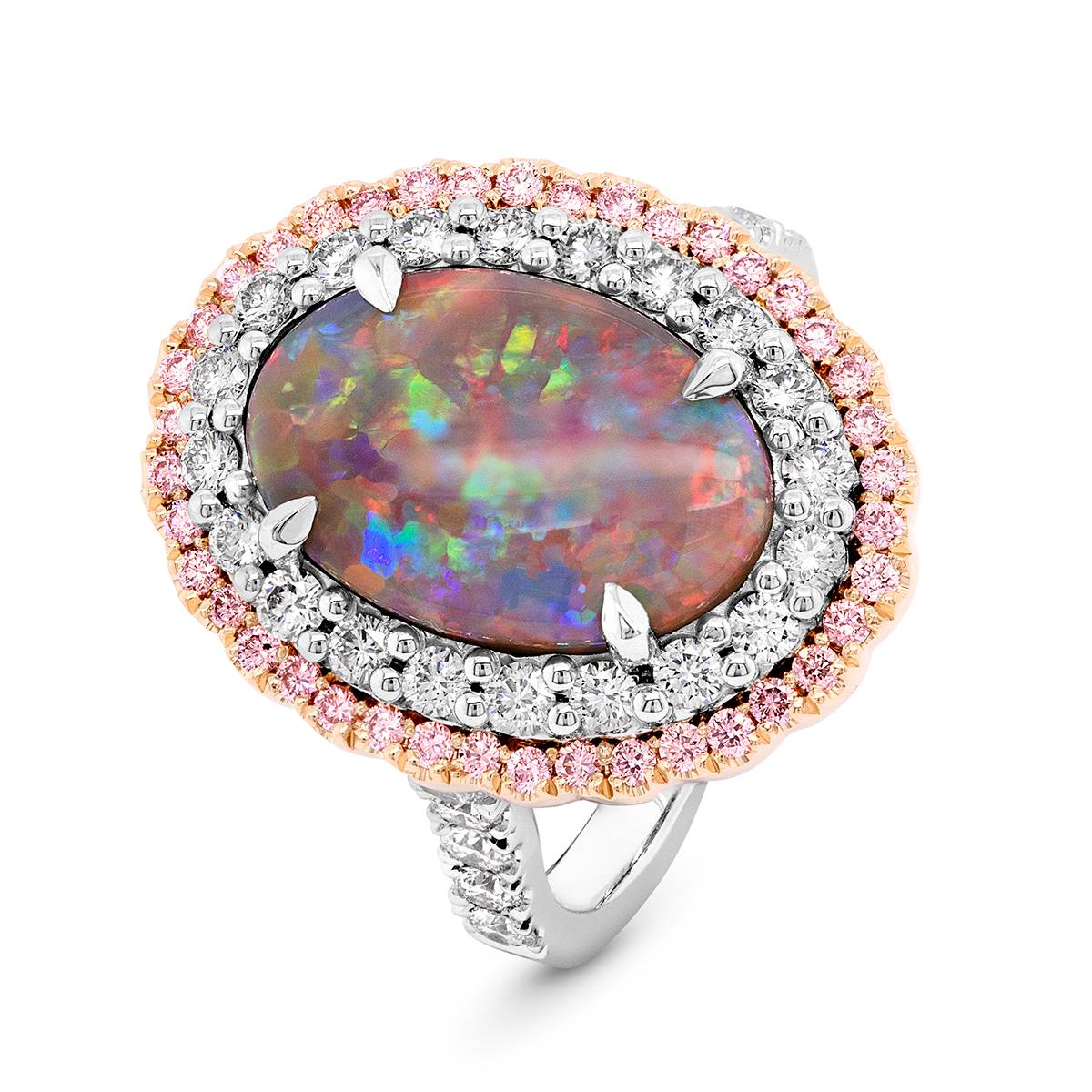Australia has been the world’s leading source of precious opal for more than 140 years, with mining operations spread across the arid interior regions of New South Wales, Queensland, and South Australia.
This remote yet iconic landscape, the margins of the Great Artesian Basin, continues to yield one of nature’s most distinctive – and now coveted – colour gemstones.
Despite the increasing popularity of Australian opal in domestic and international markets, this unique industry finds itself at a critical juncture. Facing compounding economic, regulatory, and structural challenges, critical impositions are threatening the long-term viability of these mining operations.
Australian opal holds a distinctive place in the global gemstone hierarchy. While diamonds, rubies, sapphires, emeralds, and pearls dominate the upper echelon of consumer awareness and remain prestigious treasures, opal has emerged as a vital part of the next echelon of premium colour gemstones.
Its appeal is well-established among leading international jewellery brands and manufacturers. Australian opal is increasingly incorporated into these luxury collections, as designers are attracted by its natural brilliance, unique optical phenomena, and the romantic provenance of the outback.
» Tiffany & Co.’s Blue Book 2024 featured the ‘Star Burst’ chapter, complete with jewellery highlighting the chemistry of diamonds and crystal opal in show-stopping luxury designs.
Chief artistic officer Nathalie Verdeille said the inspiration for the collection was the brilliant luminosity of galaxies in the night sky, and explained that exceptional crystal opal surrounded by diamonds was the best way to represent this visually striking phenomenon.
» Australian opal has appeared in many designs from Cartier in recent years. When a new flagship store was opened in Sydney in 2022, it was complete with the ‘Opal Bar’ – a curved turquoise marble counter where shoppers can taste cocktails.
In an interview with the Australian Financial Review, creative director Jacqueline Karachi said she once dismissed opal as far too ‘common’; however, because of the natural beauty of these gemstones, it has proven too enchanting to ignore.
» When Louis Vuitton released the Virtuosity collection, the Savoir suite featured a leading necklace with a 30-carat black opal flanked with the brand’s motifs.
The piece took more than 1,500 hours to complete and is accompanied by a pair of earrings, a ring, and a bracelet, each glittering with opal.
Indeed, the rising status of Australian opal as a colour gemstone of desire in the high-end sphere has given it a firm foothold in the luxury market. With that said, it’s an industry under pressure.
The broader luxury goods market is facing a prolonged period of heightened uncertainty, shaped by ongoing geopolitical tension, macroeconomic instability, trade barriers and disputes, and shifts in consumer confidence and discretionary spending.
The colour gemstone industry, which relies on discretionary spending, is often the first to suffer during an economic downturn and, by extension, is the last to recover.
Trade fairs are the traditional commercial engines of the opal trade. Events in Tucson, Hong Kong, Las Vegas, and Geneva, to name but a few, have seen diminished attendance and transactional activity over the past two years for varying reasons.
The more pressing, structural threat to the industry lies in a significant and sustained decline in production.
Australia’s opal production has contracted sharply over the past five years. While part of this decline is attributable to the finite nature of opal-bearing ground, the predominant cause is the decreasing number of active miners and prospectors.
The reasons for the decline in the overall workforce are complex. Rising operational costs, such as diesel, equipment, and labour, have contributed to this issue, as has restrictive environmental and land access regulations and a lack of practical and financial support for small-scale operators.
Many miners have left the opal fields to take up work in coal, gas, and mineral ore production operations around various parts of Australia.
These experienced miners are understandably attracted to the higher wages, favourable working conditions, and, perhaps most importantly, regular and sustainable income. Furthermore, the opal industry is demographically skewed.
The average age of an opal miner is increasing, and newer entrants to the gemstone fields – the next generation of the trade – are exceedingly rare.
Despite a valuable boost in visibility from several popular television series, such as Outback Opal Hunters, the realities of a high-risk, high-cost, and bureaucratically complex working environment are deterring the next generation.
Indeed, opal mining is a very easy pursuit to romanticise with its sense of adventure, discovery, and freedom.
However, there are other factors that weigh heavily on those considering making the leap.
Regulatory Red Tape & Land Access Challenges
The opal mining industry faces mounting friction with competing land-use interests and policy frameworks. Government decisions in recent years have constrained access to proven and prospective opal fields.
• One example is the permanent closure of Mintabie in South Australia, with the land returned to the APY (Anangu Pitjantjatjara Yankunytjatjara) people.
 |
| Ikecho |
The opal fields at Coober Pedy, Mintabie, and Andamooka, once supplied most of the world’s precious opal, with significant exports headed to Asia, Europe, and the US.
The Pitjantjatjara Land Rights Bill 1980 recognised that opal mining would continue in Mintabie and included provisions to control that activity.
Nearly four decades later, in 2018, the state government declared that it would not renew any leases in the town. All land was leased from the government, meaning this amounted to a compulsory closure of the town in 2019.
Management of the land was reverted to the local Aboriginal land council, Anangu Pitjantjatjara Yankunytjatjara.
• More recently, the conversion of Vergemont Station, a large area of productive ground in Queensland, into a protected National Park, was a devastating blow for local miners.
Vergemont Station, located 140 kilometres west of Longreach, was acquired in a joint purchase by the Queensland government and the Nature Conservancy. The purchase was finalised after an anonymous donation of $21 million.
The 352,000-ha property had been for sale since 2016.
Two neighbouring stations, Tonkoro (138,200ha) and Melrose (73,048ha) - were also purchased by the state government and added to existing national parks.
These purchases led to speculation within the opal industry that Vergemont would be converted into a national park — speculation that has now been proven accurate.
 |
| Ellendale Diamonds |
Queensland’s environment minister, Leanne Linard, said the government would work with the industry to ensure the future of opal mining. The opal mining industry had little faith in this commitment.
Queensland Boulder Opal Association president Alison Summerville described the purchase as a ‘nuclear bomb’ striking the mining industry.
• Meanwhile, in New South Wales, a prolonged shutdown of opal mining occurred due to administrative errors affecting lease renewals, highlighting severe concerns for the future of the industry.
Hundreds of opal miners had their livelihoods threatened after the discovery of an administrative error rendered their government-approved licences invalid.
A government notice stated that small-scale mineral claims granted or transferred between January 2015 and February 2023 were affected.
The review uncovered more than 3,300 mineral licences deemed invalid, impacting businesses in Lightning Ridge and White Cliffs.
Minister for Natural Resources Courtney Houssos apologised for the incident and commissioned a review.
The review was completed by former Land and Environment Court Judge and NSW Attorney General, Terry Sheahan AO.
Key figures in the opal trade criticised the recommendations, suggesting they would cripple an already struggling industry.
A working group featuring opal miners, landholders, and other key stakeholders was established to review these recommendations and advise the NSW Government.
For now, the industry anxiously awaits the outcome of this process, hoping that some positive results will eventuate as recognition of the economic potential this trade presents to these regional communities and the nation at large.
Paradox: Opal Supply & Demand
 |
| 7.07 carat Red On Black by Cody Opal |
Unlike many commodity markets, opal has historically defied classical supply-demand economics. During its production peak during the 1980s, greater availability counterintuitively stimulated global demand.
With more opal in circulation and a consistent supply available to jewellers and dealers, an expansion of consumer awareness and appreciation followed.
Mining in Koroit
In other words, it was a virtuous circle of volume and price appreciation. This historical insight supports an argument that revitalising production, rather than limiting it, can strengthen market depth and pricing.
There is more opal out there waiting to be discovered. If barriers are removed and mining is encouraged, a significant opportunity is on the horizon.
If opal miners are rewarded with better prices, there will be an increase in the production of, and by extension a stimulus in the promotion of this uniquely beautiful Australian gift from nature.
As mentioned, some of the world’s leading figures in the luxury market – Tiffany & Co., Louis Vuitton, and Cartier, to name just a few – are ready to play their part.
Beyond these luxury ‘titans’, it is also important to consider the market impact of opal jewellery for traditional retailers.
With diamonds facing structural disruption from the ‘noise’ created by lab-created diamond alternatives, retailers are turning to colour gemstones, where margins are better and prices are stable.
Furthermore, consumers are increasingly willing to ‘experiment’ with non-traditional options for important luxury purchases, such as engagement jewellery.
Consumers are also increasingly attracted to natural and untreated gemstones with a clear and easy-to-understand provenance and verifiable ethical sourcing credentials. Opal is ticking all the right boxes!
Indeed, Australian opal meets these criteria. It is not treated or enhanced, and is mined under one of the world’s most transparent and environmentally regulated frameworks.
This positions the gemstone to capture a share in the shifting luxury consumer landscape, particularly among younger, values-driven customers.
That said, emerging consumer markets, including China, also represent an opportunity. Opal has gained traction on social commerce platforms such as Little Red Book and Alibaba.
This is fuelled by influencer marketing and increasing consumer literacy and knowledge of gemstones.
However, restrictive duties, taxes, and capital controls currently impede larger-scale market penetration. Improved trade arrangements or tariff concessions could unlock significant expansion in this high-potential region.
Industry Leadership
For far too long, the Australian opal industry has suffered greatly from the tactics of unscrupulous traders who have passed off dyed or smoked hydrophane opal, and even synthetic black opal, as ‘the real deal’ – authentic black opal.
Similar issues have been noted within the industry regarding unstable porous opal, which is deceptively traded as solid Australian light opal.
The inconsistent and haphazard use of terms and deceptions for opal types has enabled these deceptions and scams to succeed at times, and consumers and jewellery store owners are being misled.
Industry stakeholders, including representatives from the Gemmological Association of Australia, the Australian Opal Association, and the Jewellers Association of Australia, have held consultations.
The World Jewellery Confederation (CIBJO) has been provided with a framework to classify opal from all of the world’s deposits.
A team of Australian representatives is now working with CIBJO to develop a comprehensive Opal Guide that will provide the standards for opal classification and nomenclature.
It’s hoped that this framework will standardise the language used in the colour gemstone and opal industry and, as a result, reduce opportunities for these aforementioned unscrupulous traders to employ misleading and deceptive practices, which trade a ‘quick buck’ for consumer faith and trust in the industry.
Ethics & Values
Seven years ago, I co-authored an article with Dr. Laurent Cartier and opal expert John Winch, published in InColor magazine.
The purpose of the article – ‘Australian Opal Mining: A Model for Responsible Mining’- was to outline the sustainability credentials of the opal industry.
While the world has dramatically changed over the past decade, the facts outlined in that article remain critically relevant today. They highlight how the uniquely homegrown provenance of opal is a major victory for all stakeholders — miners, jewellers, and consumers.
Explained simply, today’s consumers are spoiled for choice when shopping online for luxury goods, including colour gemstone jewellery. Many modern consumers have embraced responsible sourcing and sustainable mining as important factors during the purchasing decision.
Colour gemstones are diverse in species and source distribution. Many are found in underdeveloped and remote locations.
The varying geography, political environments, and socio-economic conditions of these locations have created a fragmented supply chain.
This means that tracing most gemstones throughout the supply chain is difficult, raising uncertainty among consumers. Australian opal defies these conditions.
Opal mining in Australia is regulated under strict work, health, and safety laws.
There is separate legislation in Queensland, New South Wales, and South Australia. Safety training is mandatory, contributing to a strong record, with few fatalities reported in the trade’s 140-year history.
Federal and state acts govern environmental protection, and miners must rehabilitate sites and follow strict operational standards. Native Title and Indigenous Land Use Agreements ensure traditional owner involvement and the protection of Aboriginal cultural heritage.
Indeed, the Aboriginal peoples of Australia maintain the oldest continuous living cultures in the world. Opal features in some belief systems and dreamtime stories that involve the Rainbow Serpent, the creator of Aboriginal mythology.
As mentioned, miners must comply with workplace laws and most operations are undertaken by the owners. Historical mining areas are also preserved as cultural heritage sites, celebrating the resilience of early pioneers.
Environmental and community initiatives highlight the social responsibility displayed by miners. The opal industry plays a vital role in sustaining remote communities, many of which owe their existence to mining.
Australia’s ethical, legal, and governance frameworks support transparent and fair trade.
Treatments are minimal, with strict disclosure requirements ensuring consumer protection.
These facts have not changed. The opal industry upholds high safety, sustainability, heritage preservation, and ethical conduct standards.
“The Australian opal mining industry has strong credentials as a responsible and sustainable gem mining industry. Consumers buying Australian opal can do so with the assurance that the gemstone they are buying is an ethical gemstone,” the article concluded.
“This reputation provides a strategic advantage in a global marketplace where ethical sourcing and transparency are no longer optional — they are expected.”
Strategic Imperatives & The Future
The Australian opal industry has a compelling product, deep cultural roots, and a powerful global reputation; however, it requires strategic support.
To thrive into the next generation, the following key priorities must be addressed:
» Regulatory reform: Streamline and clarify lease approvals, environmental compliance, and Native Title procedures.
» Financial support: Provide training programmes and financial incentives for new miners and relief for operational cost burdens.
» Land access policy: Ensure opal-bearing lands are not arbitrarily restricted for other uses without thorough consultation with all stakeholders and impact assessment.
» Trade policy: Pursue favourable trade arrangements, particularly with emerging Asian markets.
» Marketing investment: Support coordinated international campaigns that promote opal’s ethical sourcing, natural rarity, and design versatility.
Australian opal remains one of the world’s most vibrant and aesthetically beautiful gemstones. It is a product of the country’s landscape, natural riches and pioneering spirit — and it is a product worthy of preserving and promoting.
If state and federal governments act in partnership with industry stakeholders, Australia can ensure that this iconic gemstone continues to glitter on the world stage, both as a commercial success and as a model for responsible, small-scale mining.
The industry’s challenges are significant, but so too is its potential. With the proper policy framework, opal can continue to illuminate not only jewellery showcases, but also regional economies and Australia’s identity as a trusted global gemstone supplier.
READ EMAG